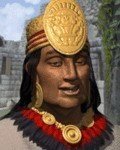The Incans |
|||||||||||||||||||||||
| Profile | |||||||||||||||||||||||
|
|||||||||||||||||||||||
|
Incan Cities
Great Leaders Military Leaders:
Scientific Leaders:
|
Background Hundreds of years ago, a group of people calling themselves the Inca settled the Cuzco Valley high in the Andes Mountains of South America. Where they had come from was a mystery. Yet, though their purpose for settling such a rugged and inhospitable landscape was unclear, the end result of their arrival is without doubt. In time, the Inca built an empire that spanned the Pacific coast (as far south as Argentina and as far north as Ecuador), some 2,000 miles of hills, mountains, valleys and coastline. In just a short time (roughly 100 years), the Incan empire dominated South America and is, to this day, considered one of the finest empires the world has ever known. Beginning with the ninth ruler, Pachacuti Inca Yupanqui, the Inca began their expansion. Pachacuti won his first military campaign against the Chanca people, where he refused to retreat despite insurmountable odds. From there, he consolidated his control over his cultural base, Cuzco, then moved north into the Urubamba Valley, which extended beyond the site where the lost city of Mach Picchu was later built. He then turned his army south and conquered the Colla and Lupaca tribes. Though not the first Incan ruler, Pachacuti was by many accounts one of the finest Pre-Columbian persons that ever lived. A great military strategist, an architect, a skilled diplomat and a gifted religious philosopher, his teachings are still practiced by many Andeans today. Like many other groups that preceded the Inca (the Chimu, the Nazca, the Moche), Incan society was heavily dipped in the worship of powerful gods. Their pantheon contained such lofty omnipotents as Viracocha (the god of creation), Inti (the sun and father of the Inca Dynasty), Illapa (god of rain, thunder, and lightening), Pacha Mama (mother of the earth), and Mama Cocha (mother of the lakes). Grand ceremonies were held frequently to honor these gods, for the Inca believed that if one did not give thanks and obedience to the gods, bad things would happen. The world of the Andes Mountains is full of ecological wonders and ecological disasters: Earthquakes, severe storms, and volcanic activity. The gods held sway with these events and thus the proper respect had to be paid at all times. The Inca called their empire Tahuantinsuyu (“Land of the Four Quarters”), which was divided into four provinces. Each province was controlled by a local governor called the apu; below him were the local rulers – the curacas, and even lower still the district headsmen – the camayoc. Through this governmental structure, the Sapa-Inca could rule the empire with impunity. Additional structures were also put in place, such as the Imperial road system, which was built along the steep inclines of mountains, interspersing bridges and stone walkways, stone steps and flat brick highways. To rule such a vast realm, the Sapa-Inca also needed constant information about the status of the far-flung reaches of the kingdom. To provide this information, the Inca formed the Chasqui Scout system. Chasquis delivered messages across the empire, relaying (by memory) important information from point to point. And in this way, a message about a peasant uprising hundreds of miles north of Cuzco could reach the king within a matter of days. Chasquis were also used by the army on campaigns to deliver messages between the moving columns. In addition, way-stations known as tambos were constructed at strategic points along the roads, giving travelers and important dignitaries a place to rest and prepare for the next leg of their journey. The Incan army was also well organized. When called upon to fight, each province would muster squadrons of men armed with maces, bows and arrows, slings, darts, and spears. During a battle, slingers would let fly a shower of rocks to soften the enemy lines. Then, archers would release their shafts, darts would fly, and then the shock troops would hit, in a torrent of screams and shouts meant to confuse and terrify the wavering opposition. Incan warfare was very successful. But nothing could prepare the empire for what was coming. After the glorious rise of Pachacuti and his son, Topa Inca, the empire began to erode under a series of internal and external disasters. A bitter civil war between half brothers Huascar and Atahuallpa stretched the empire to the breaking point. Atahuallpa won the war, quickly killed his half-brother, and declared himself king. But, in 1532 AD, Spanish Conquistadors, under the command of Francisco Pizarro, entered the Cajamarca Valley, brutally attacked Atahuallpa and his subjects, killing many and taking the Sapa-Inca hostage. Eventually, Pizarro killed Atahuallpa, pillage the empire of its riches, and brought an end to the mighty Incan civilization. In Civilization III: Conquests, the Incans are considered to be an expansionist and agricultural civilization. They start the game with Pottery and Masonry. They also begin the game with a regular Scout and may build their unique Chasqui Scout units thereafter. Unique Unit: Chasqui Scout The Chasqui scout system was the Incan equivalent to the Pony Express. Fast, agile, and capable of running long distances, Chasqui scouts carried memorized messages along the Imperial road systems of the Andes Mountains. Couriers donned with distinctly white feathered headdresses, Chasquis would memorize information, carry it to other scouts waiting along the relay system, and then run along with them until they memorized the message, and so on until the message was delivered. In this way, a message could travel over hundreds of miles within a few short days. Chasqui scouts were also used by the Incan army on campaign, to retrieve and deliver messages between the moving columns. The Incan Chasqui Scout is a scout unit that replaces the basic scout for the Inca. He has a modest attack and defensive capability. He is also very fast and ignores movement costs for both hills and mountains.
|
||||||||||||||||||||||


